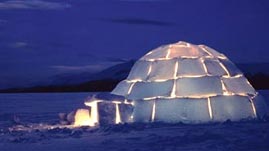Teachers' Domain - Digital Media for the Classroom and Professional Development
User: Preview

Source: NOVA: "Arctic Passage"



This interactive activity from NOVA challenges students' knowledge of igloo construction. The quiz format includes questions concerning where igloos were traditionally built, the best type of snow for building, and the shape on which these traditional Canadian Inuit structures were modeled. Detailed explanations provide further insight into how these ingenious snow shelters enabled entire families to survive the brutal Arctic winters.
Over the past several decades, indigenous peoples of the Arctic region, including Aleuts, Inuit, and Sámi, have blended many parts of Western civilization into their traditional lifestyles. Many who in times past would have engaged in subsistence hunting, fishing, and trapping now hold corporate jobs in the mining, oil, and gas industries. Traditional modes of transport, including snowshoes, kayaks, and dogsleds, have been replaced by mechanized vehicles, including cars and trucks, motor boats, and snowmobiles. Also gone, by and large, from the Arctic winter landscape are the iconic snow-and-ice structures called igloos. Formerly nomadic populations now live in communities of permanent houses equipped with modern conveniences.
All over the world, indigenous peoples have adapted their lifestyles to local environmental conditions. The structures they build are the product of both a builder's reliance on and knowledge of local resources. They use that which is readily available for building materials, and their architectural designs are the product of the function they serve and the environment in which they live. For example, the Navajo use adobe blocks made of clay, which offer superior insulation and waterproofing properties, to construct their homes in the southwestern deserts.
The igloo, derived from the Inuit word igdlu, meaning "house," was a Canadian Inuit adaptation. In sub-zero winters, Arctic people could not rely on their caribou- and seal-skin tents. Whether a hunter needed a temporary overnight shelter, or a family needed a semi-permanent dwelling, they made use of the most readily available resource—snow. The best snow for building an igloo had been blown by wind and compacted, allowing ice crystals to interlock. The only building tool required was a knife about a foot long, made of caribou antler or ivory. Using an ingenious and time-honored technique, whereby blocks were laid down row upon row, in tighter and tighter circles, a livable igloo could be built in only a few hours.
An igloo derived its strength to withstand whipping winds and potential polar bear attacks from an inherently strong shape: the dome. As an igloo settled in the snow, it compressed slightly and became stronger. The shape also served to trap warm air generated by body heat or a cooking fire. A small opening at the top allowed some of the heat and smoke to escape.
Because of snow's excellent insulating properties, the temperature inside an igloo could reach about 65°F warmer than the outside air. The igloo actually benefited from some melting, because when melted snow refroze, it formed a thin, hard shell. Moreover, the tiny snow-filled spaces between the blocks also froze, binding the structure more tightly together.
 Loading Standards
Loading Standards Teachers' Domain is proud to be a Pathways portal to the National Science Digital Library.
Teachers' Domain is proud to be a Pathways portal to the National Science Digital Library.
